Nutrition Vulnerability Among Older Adults: Nursing Assessment
VerifiedAdded on 2023/06/07
|12
|3399
|68
Report
AI Summary
This report addresses the critical issue of nutrition vulnerability among older adults, a growing concern given the increasing aging population worldwide. It identifies key risk factors contributing to malnutrition in the elderly, including poor mobility, mental health issues, swallowing difficulties, and socioeconomic factors. The report recommends strategies for risk reduction, such as promoting healthier food choices, encouraging snacking on nutritious foods, and fostering physical activity and social engagement. It emphasizes the essential role of nurses in identifying at-risk patients, utilizing screening tools, and implementing practice changes to improve nutritional care. Furthermore, the report evaluates the implications of environmental changes (natural, social, and governmental) on nursing care, highlighting the need for nurses to adapt to evolving circumstances and maintain high standards of care. The report concludes by stressing the importance of specialized skills and patience in caring for older adults with malnutrition, ensuring their well-being and preventing readmission.
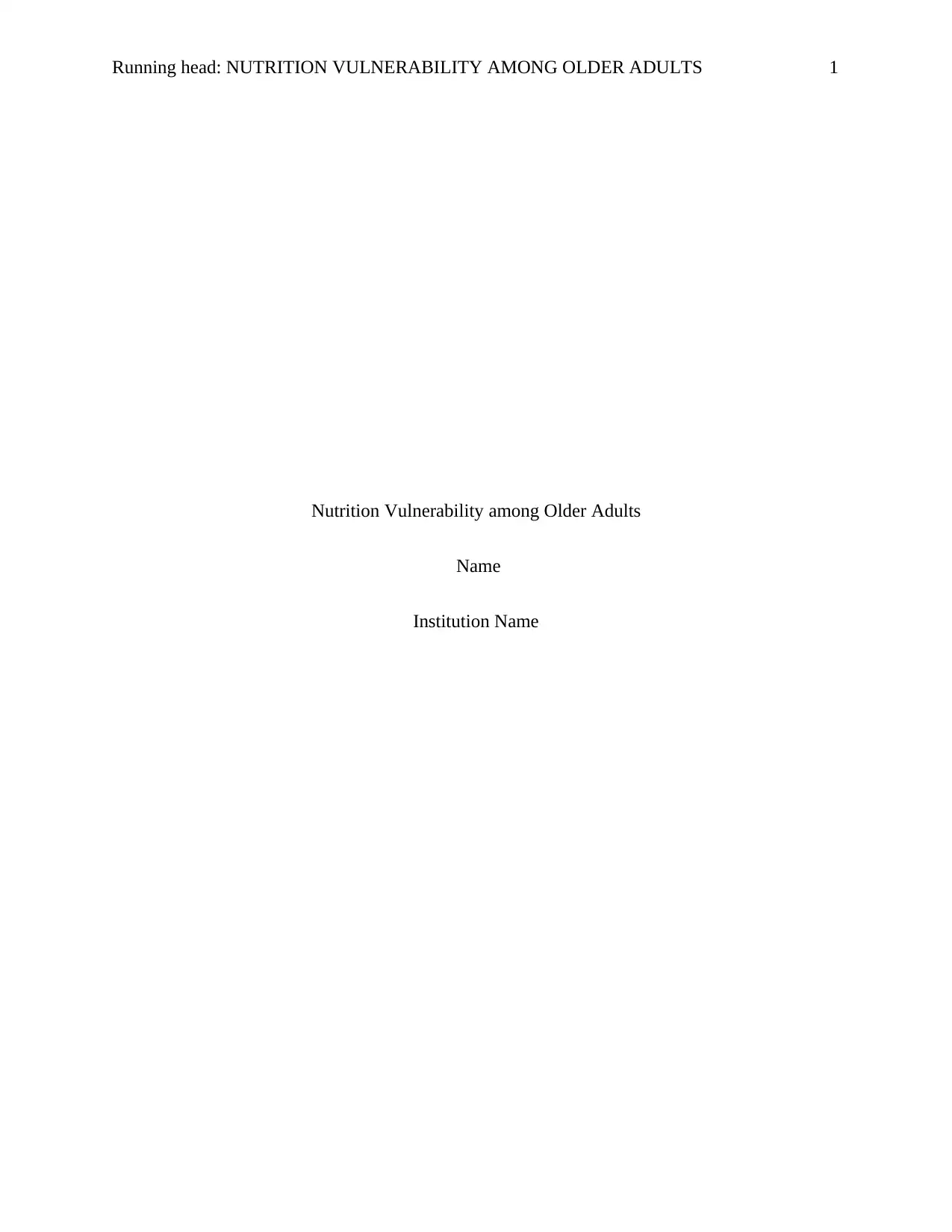
Running head: NUTRITION VULNERABILITY AMONG OLDER ADULTS 1
Nutrition Vulnerability among Older Adults
Name
Institution Name
Nutrition Vulnerability among Older Adults
Name
Institution Name
Paraphrase This Document
Need a fresh take? Get an instant paraphrase of this document with our AI Paraphraser
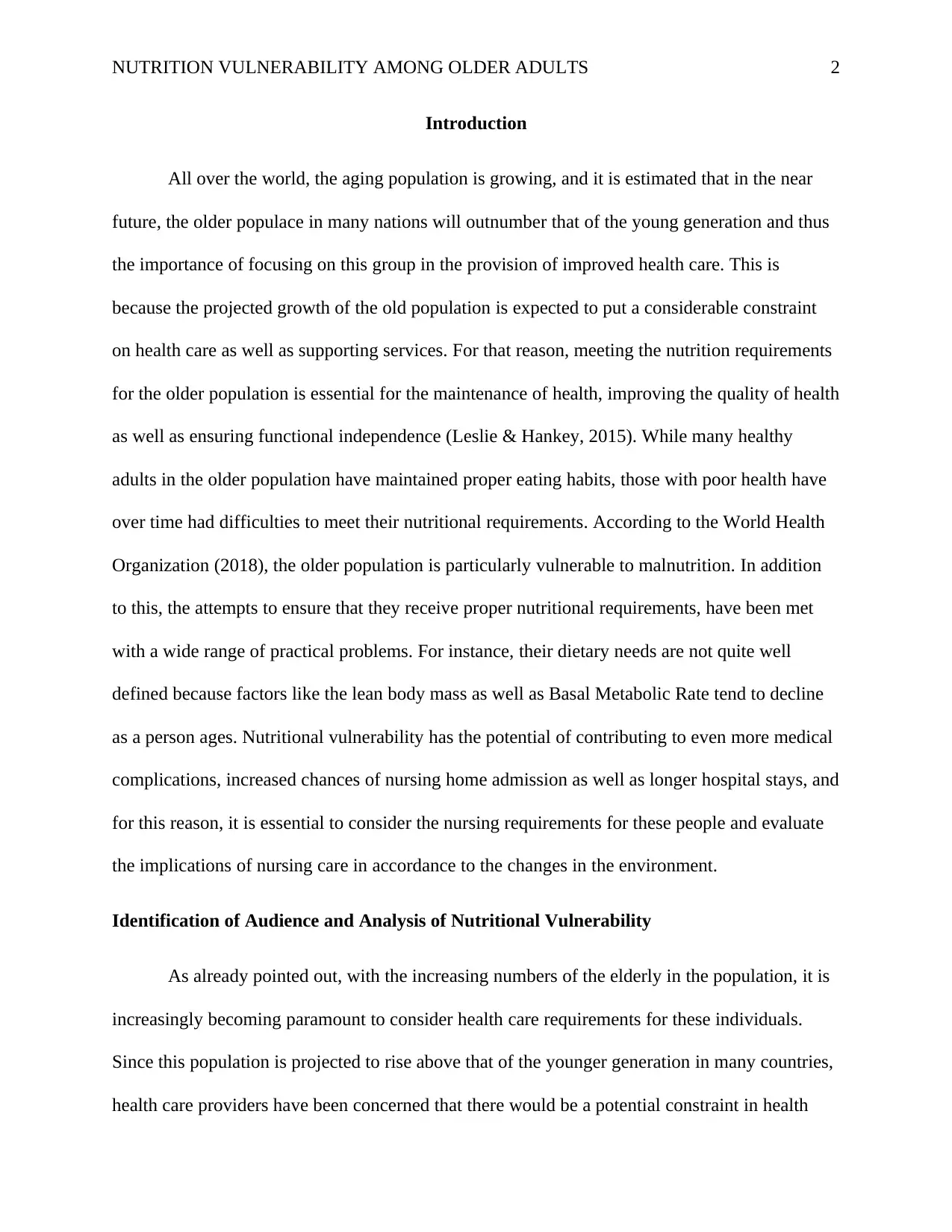
NUTRITION VULNERABILITY AMONG OLDER ADULTS 2
Introduction
All over the world, the aging population is growing, and it is estimated that in the near
future, the older populace in many nations will outnumber that of the young generation and thus
the importance of focusing on this group in the provision of improved health care. This is
because the projected growth of the old population is expected to put a considerable constraint
on health care as well as supporting services. For that reason, meeting the nutrition requirements
for the older population is essential for the maintenance of health, improving the quality of health
as well as ensuring functional independence (Leslie & Hankey, 2015). While many healthy
adults in the older population have maintained proper eating habits, those with poor health have
over time had difficulties to meet their nutritional requirements. According to the World Health
Organization (2018), the older population is particularly vulnerable to malnutrition. In addition
to this, the attempts to ensure that they receive proper nutritional requirements, have been met
with a wide range of practical problems. For instance, their dietary needs are not quite well
defined because factors like the lean body mass as well as Basal Metabolic Rate tend to decline
as a person ages. Nutritional vulnerability has the potential of contributing to even more medical
complications, increased chances of nursing home admission as well as longer hospital stays, and
for this reason, it is essential to consider the nursing requirements for these people and evaluate
the implications of nursing care in accordance to the changes in the environment.
Identification of Audience and Analysis of Nutritional Vulnerability
As already pointed out, with the increasing numbers of the elderly in the population, it is
increasingly becoming paramount to consider health care requirements for these individuals.
Since this population is projected to rise above that of the younger generation in many countries,
health care providers have been concerned that there would be a potential constraint in health
Introduction
All over the world, the aging population is growing, and it is estimated that in the near
future, the older populace in many nations will outnumber that of the young generation and thus
the importance of focusing on this group in the provision of improved health care. This is
because the projected growth of the old population is expected to put a considerable constraint
on health care as well as supporting services. For that reason, meeting the nutrition requirements
for the older population is essential for the maintenance of health, improving the quality of health
as well as ensuring functional independence (Leslie & Hankey, 2015). While many healthy
adults in the older population have maintained proper eating habits, those with poor health have
over time had difficulties to meet their nutritional requirements. According to the World Health
Organization (2018), the older population is particularly vulnerable to malnutrition. In addition
to this, the attempts to ensure that they receive proper nutritional requirements, have been met
with a wide range of practical problems. For instance, their dietary needs are not quite well
defined because factors like the lean body mass as well as Basal Metabolic Rate tend to decline
as a person ages. Nutritional vulnerability has the potential of contributing to even more medical
complications, increased chances of nursing home admission as well as longer hospital stays, and
for this reason, it is essential to consider the nursing requirements for these people and evaluate
the implications of nursing care in accordance to the changes in the environment.
Identification of Audience and Analysis of Nutritional Vulnerability
As already pointed out, with the increasing numbers of the elderly in the population, it is
increasingly becoming paramount to consider health care requirements for these individuals.
Since this population is projected to rise above that of the younger generation in many countries,
health care providers have been concerned that there would be a potential constraint in health
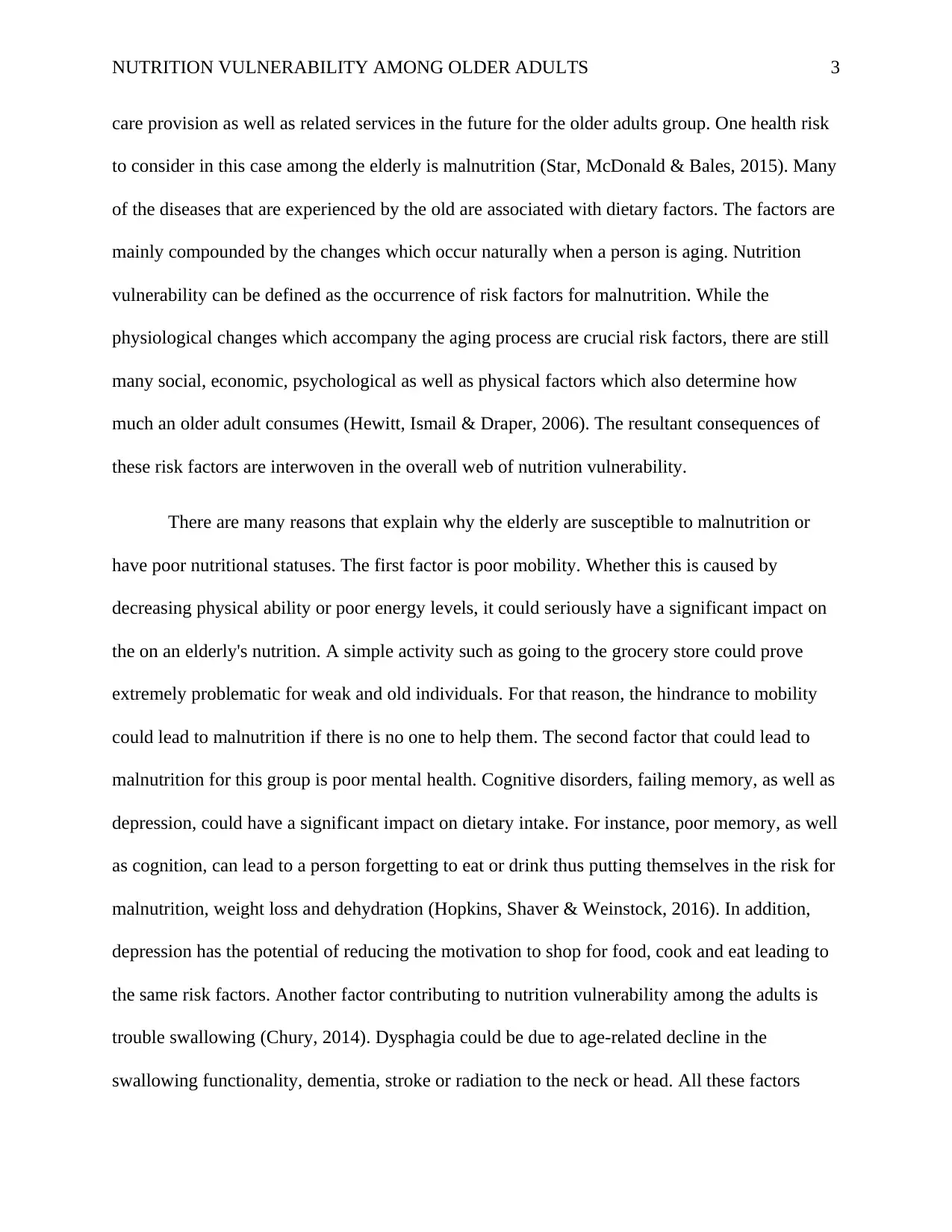
NUTRITION VULNERABILITY AMONG OLDER ADULTS 3
care provision as well as related services in the future for the older adults group. One health risk
to consider in this case among the elderly is malnutrition (Star, McDonald & Bales, 2015). Many
of the diseases that are experienced by the old are associated with dietary factors. The factors are
mainly compounded by the changes which occur naturally when a person is aging. Nutrition
vulnerability can be defined as the occurrence of risk factors for malnutrition. While the
physiological changes which accompany the aging process are crucial risk factors, there are still
many social, economic, psychological as well as physical factors which also determine how
much an older adult consumes (Hewitt, Ismail & Draper, 2006). The resultant consequences of
these risk factors are interwoven in the overall web of nutrition vulnerability.
There are many reasons that explain why the elderly are susceptible to malnutrition or
have poor nutritional statuses. The first factor is poor mobility. Whether this is caused by
decreasing physical ability or poor energy levels, it could seriously have a significant impact on
the on an elderly's nutrition. A simple activity such as going to the grocery store could prove
extremely problematic for weak and old individuals. For that reason, the hindrance to mobility
could lead to malnutrition if there is no one to help them. The second factor that could lead to
malnutrition for this group is poor mental health. Cognitive disorders, failing memory, as well as
depression, could have a significant impact on dietary intake. For instance, poor memory, as well
as cognition, can lead to a person forgetting to eat or drink thus putting themselves in the risk for
malnutrition, weight loss and dehydration (Hopkins, Shaver & Weinstock, 2016). In addition,
depression has the potential of reducing the motivation to shop for food, cook and eat leading to
the same risk factors. Another factor contributing to nutrition vulnerability among the adults is
trouble swallowing (Chury, 2014). Dysphagia could be due to age-related decline in the
swallowing functionality, dementia, stroke or radiation to the neck or head. All these factors
care provision as well as related services in the future for the older adults group. One health risk
to consider in this case among the elderly is malnutrition (Star, McDonald & Bales, 2015). Many
of the diseases that are experienced by the old are associated with dietary factors. The factors are
mainly compounded by the changes which occur naturally when a person is aging. Nutrition
vulnerability can be defined as the occurrence of risk factors for malnutrition. While the
physiological changes which accompany the aging process are crucial risk factors, there are still
many social, economic, psychological as well as physical factors which also determine how
much an older adult consumes (Hewitt, Ismail & Draper, 2006). The resultant consequences of
these risk factors are interwoven in the overall web of nutrition vulnerability.
There are many reasons that explain why the elderly are susceptible to malnutrition or
have poor nutritional statuses. The first factor is poor mobility. Whether this is caused by
decreasing physical ability or poor energy levels, it could seriously have a significant impact on
the on an elderly's nutrition. A simple activity such as going to the grocery store could prove
extremely problematic for weak and old individuals. For that reason, the hindrance to mobility
could lead to malnutrition if there is no one to help them. The second factor that could lead to
malnutrition for this group is poor mental health. Cognitive disorders, failing memory, as well as
depression, could have a significant impact on dietary intake. For instance, poor memory, as well
as cognition, can lead to a person forgetting to eat or drink thus putting themselves in the risk for
malnutrition, weight loss and dehydration (Hopkins, Shaver & Weinstock, 2016). In addition,
depression has the potential of reducing the motivation to shop for food, cook and eat leading to
the same risk factors. Another factor contributing to nutrition vulnerability among the adults is
trouble swallowing (Chury, 2014). Dysphagia could be due to age-related decline in the
swallowing functionality, dementia, stroke or radiation to the neck or head. All these factors
⊘ This is a preview!⊘
Do you want full access?
Subscribe today to unlock all pages.

Trusted by 1+ million students worldwide
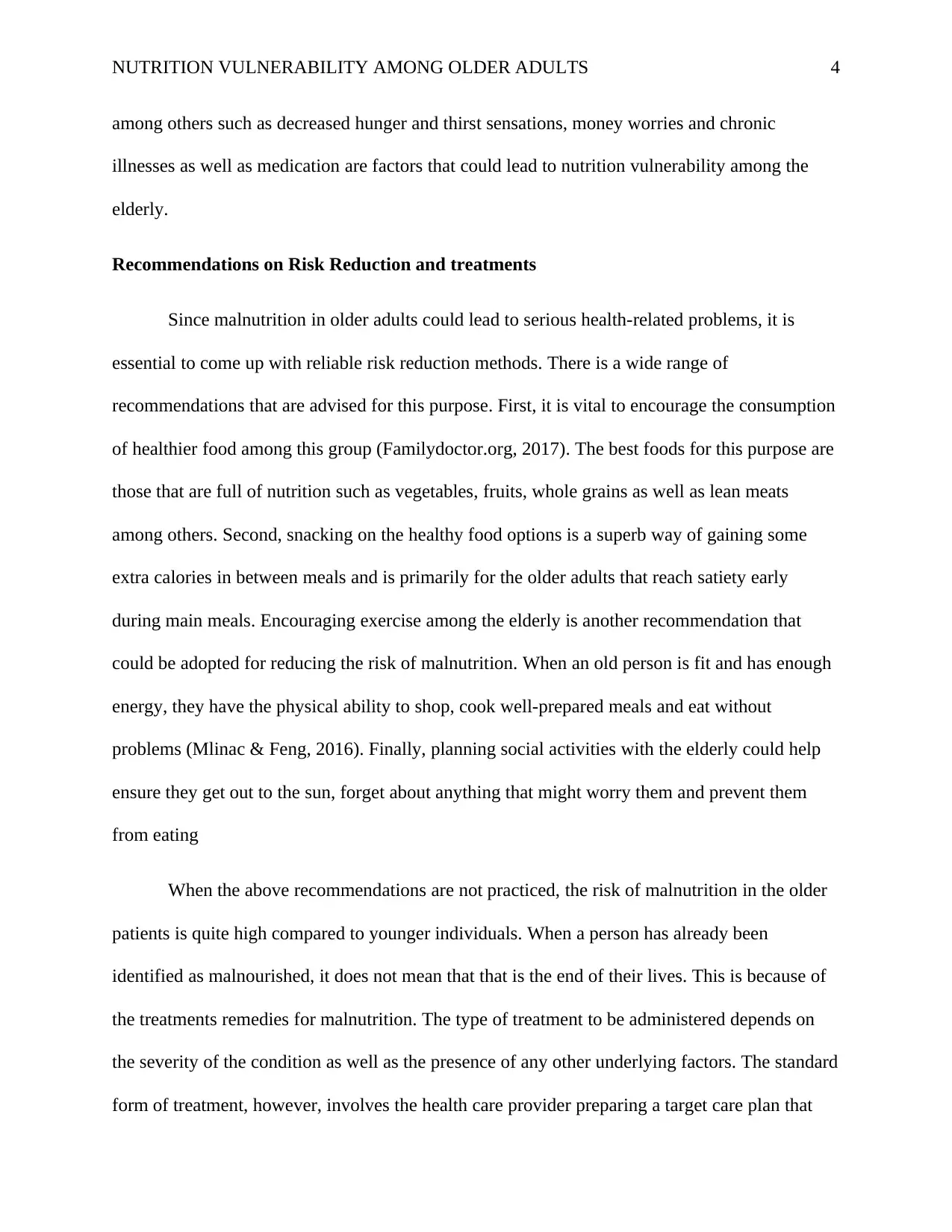
NUTRITION VULNERABILITY AMONG OLDER ADULTS 4
among others such as decreased hunger and thirst sensations, money worries and chronic
illnesses as well as medication are factors that could lead to nutrition vulnerability among the
elderly.
Recommendations on Risk Reduction and treatments
Since malnutrition in older adults could lead to serious health-related problems, it is
essential to come up with reliable risk reduction methods. There is a wide range of
recommendations that are advised for this purpose. First, it is vital to encourage the consumption
of healthier food among this group (Familydoctor.org, 2017). The best foods for this purpose are
those that are full of nutrition such as vegetables, fruits, whole grains as well as lean meats
among others. Second, snacking on the healthy food options is a superb way of gaining some
extra calories in between meals and is primarily for the older adults that reach satiety early
during main meals. Encouraging exercise among the elderly is another recommendation that
could be adopted for reducing the risk of malnutrition. When an old person is fit and has enough
energy, they have the physical ability to shop, cook well-prepared meals and eat without
problems (Mlinac & Feng, 2016). Finally, planning social activities with the elderly could help
ensure they get out to the sun, forget about anything that might worry them and prevent them
from eating
When the above recommendations are not practiced, the risk of malnutrition in the older
patients is quite high compared to younger individuals. When a person has already been
identified as malnourished, it does not mean that that is the end of their lives. This is because of
the treatments remedies for malnutrition. The type of treatment to be administered depends on
the severity of the condition as well as the presence of any other underlying factors. The standard
form of treatment, however, involves the health care provider preparing a target care plan that
among others such as decreased hunger and thirst sensations, money worries and chronic
illnesses as well as medication are factors that could lead to nutrition vulnerability among the
elderly.
Recommendations on Risk Reduction and treatments
Since malnutrition in older adults could lead to serious health-related problems, it is
essential to come up with reliable risk reduction methods. There is a wide range of
recommendations that are advised for this purpose. First, it is vital to encourage the consumption
of healthier food among this group (Familydoctor.org, 2017). The best foods for this purpose are
those that are full of nutrition such as vegetables, fruits, whole grains as well as lean meats
among others. Second, snacking on the healthy food options is a superb way of gaining some
extra calories in between meals and is primarily for the older adults that reach satiety early
during main meals. Encouraging exercise among the elderly is another recommendation that
could be adopted for reducing the risk of malnutrition. When an old person is fit and has enough
energy, they have the physical ability to shop, cook well-prepared meals and eat without
problems (Mlinac & Feng, 2016). Finally, planning social activities with the elderly could help
ensure they get out to the sun, forget about anything that might worry them and prevent them
from eating
When the above recommendations are not practiced, the risk of malnutrition in the older
patients is quite high compared to younger individuals. When a person has already been
identified as malnourished, it does not mean that that is the end of their lives. This is because of
the treatments remedies for malnutrition. The type of treatment to be administered depends on
the severity of the condition as well as the presence of any other underlying factors. The standard
form of treatment, however, involves the health care provider preparing a target care plan that
Paraphrase This Document
Need a fresh take? Get an instant paraphrase of this document with our AI Paraphraser
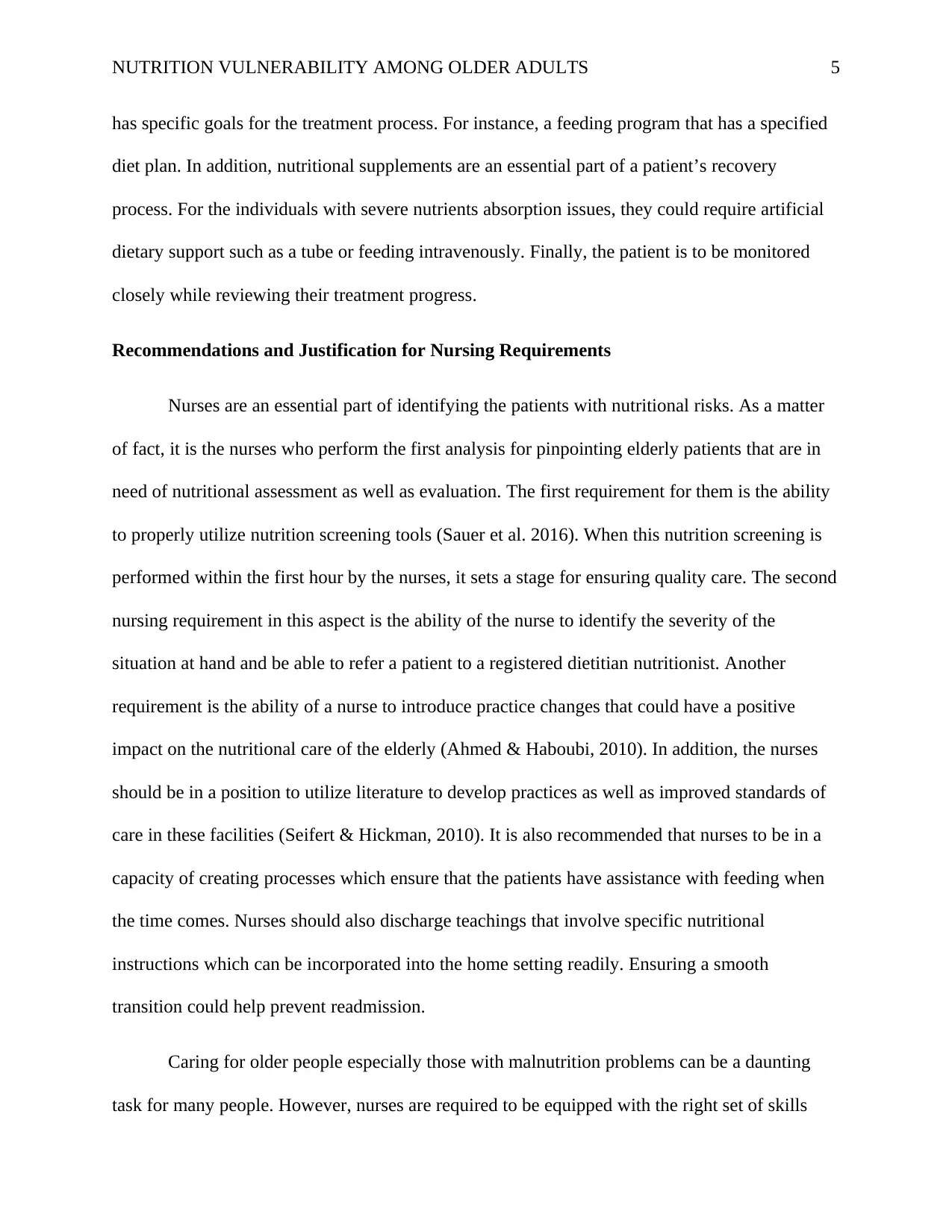
NUTRITION VULNERABILITY AMONG OLDER ADULTS 5
has specific goals for the treatment process. For instance, a feeding program that has a specified
diet plan. In addition, nutritional supplements are an essential part of a patient’s recovery
process. For the individuals with severe nutrients absorption issues, they could require artificial
dietary support such as a tube or feeding intravenously. Finally, the patient is to be monitored
closely while reviewing their treatment progress.
Recommendations and Justification for Nursing Requirements
Nurses are an essential part of identifying the patients with nutritional risks. As a matter
of fact, it is the nurses who perform the first analysis for pinpointing elderly patients that are in
need of nutritional assessment as well as evaluation. The first requirement for them is the ability
to properly utilize nutrition screening tools (Sauer et al. 2016). When this nutrition screening is
performed within the first hour by the nurses, it sets a stage for ensuring quality care. The second
nursing requirement in this aspect is the ability of the nurse to identify the severity of the
situation at hand and be able to refer a patient to a registered dietitian nutritionist. Another
requirement is the ability of a nurse to introduce practice changes that could have a positive
impact on the nutritional care of the elderly (Ahmed & Haboubi, 2010). In addition, the nurses
should be in a position to utilize literature to develop practices as well as improved standards of
care in these facilities (Seifert & Hickman, 2010). It is also recommended that nurses to be in a
capacity of creating processes which ensure that the patients have assistance with feeding when
the time comes. Nurses should also discharge teachings that involve specific nutritional
instructions which can be incorporated into the home setting readily. Ensuring a smooth
transition could help prevent readmission.
Caring for older people especially those with malnutrition problems can be a daunting
task for many people. However, nurses are required to be equipped with the right set of skills
has specific goals for the treatment process. For instance, a feeding program that has a specified
diet plan. In addition, nutritional supplements are an essential part of a patient’s recovery
process. For the individuals with severe nutrients absorption issues, they could require artificial
dietary support such as a tube or feeding intravenously. Finally, the patient is to be monitored
closely while reviewing their treatment progress.
Recommendations and Justification for Nursing Requirements
Nurses are an essential part of identifying the patients with nutritional risks. As a matter
of fact, it is the nurses who perform the first analysis for pinpointing elderly patients that are in
need of nutritional assessment as well as evaluation. The first requirement for them is the ability
to properly utilize nutrition screening tools (Sauer et al. 2016). When this nutrition screening is
performed within the first hour by the nurses, it sets a stage for ensuring quality care. The second
nursing requirement in this aspect is the ability of the nurse to identify the severity of the
situation at hand and be able to refer a patient to a registered dietitian nutritionist. Another
requirement is the ability of a nurse to introduce practice changes that could have a positive
impact on the nutritional care of the elderly (Ahmed & Haboubi, 2010). In addition, the nurses
should be in a position to utilize literature to develop practices as well as improved standards of
care in these facilities (Seifert & Hickman, 2010). It is also recommended that nurses to be in a
capacity of creating processes which ensure that the patients have assistance with feeding when
the time comes. Nurses should also discharge teachings that involve specific nutritional
instructions which can be incorporated into the home setting readily. Ensuring a smooth
transition could help prevent readmission.
Caring for older people especially those with malnutrition problems can be a daunting
task for many people. However, nurses are required to be equipped with the right set of skills
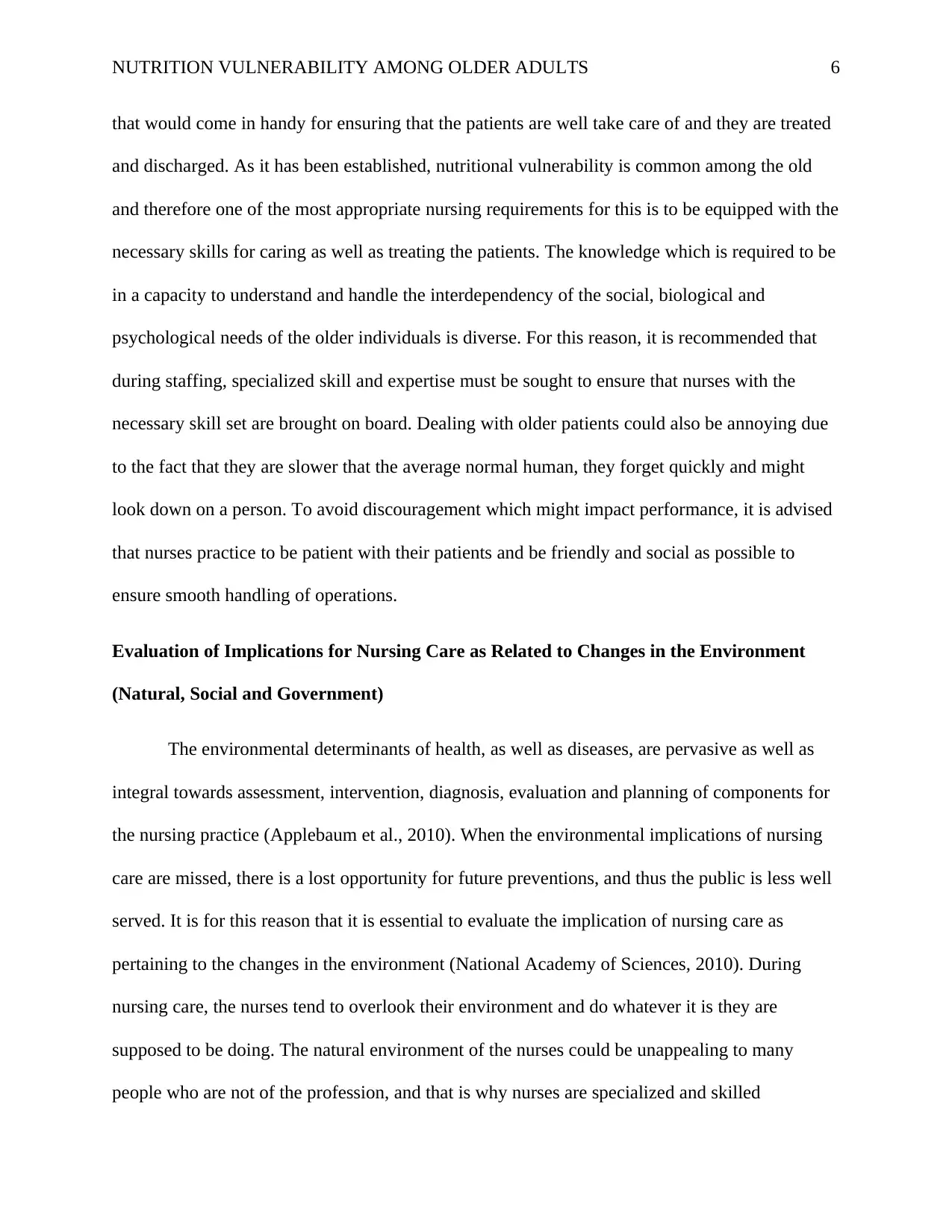
NUTRITION VULNERABILITY AMONG OLDER ADULTS 6
that would come in handy for ensuring that the patients are well take care of and they are treated
and discharged. As it has been established, nutritional vulnerability is common among the old
and therefore one of the most appropriate nursing requirements for this is to be equipped with the
necessary skills for caring as well as treating the patients. The knowledge which is required to be
in a capacity to understand and handle the interdependency of the social, biological and
psychological needs of the older individuals is diverse. For this reason, it is recommended that
during staffing, specialized skill and expertise must be sought to ensure that nurses with the
necessary skill set are brought on board. Dealing with older patients could also be annoying due
to the fact that they are slower that the average normal human, they forget quickly and might
look down on a person. To avoid discouragement which might impact performance, it is advised
that nurses practice to be patient with their patients and be friendly and social as possible to
ensure smooth handling of operations.
Evaluation of Implications for Nursing Care as Related to Changes in the Environment
(Natural, Social and Government)
The environmental determinants of health, as well as diseases, are pervasive as well as
integral towards assessment, intervention, diagnosis, evaluation and planning of components for
the nursing practice (Applebaum et al., 2010). When the environmental implications of nursing
care are missed, there is a lost opportunity for future preventions, and thus the public is less well
served. It is for this reason that it is essential to evaluate the implication of nursing care as
pertaining to the changes in the environment (National Academy of Sciences, 2010). During
nursing care, the nurses tend to overlook their environment and do whatever it is they are
supposed to be doing. The natural environment of the nurses could be unappealing to many
people who are not of the profession, and that is why nurses are specialized and skilled
that would come in handy for ensuring that the patients are well take care of and they are treated
and discharged. As it has been established, nutritional vulnerability is common among the old
and therefore one of the most appropriate nursing requirements for this is to be equipped with the
necessary skills for caring as well as treating the patients. The knowledge which is required to be
in a capacity to understand and handle the interdependency of the social, biological and
psychological needs of the older individuals is diverse. For this reason, it is recommended that
during staffing, specialized skill and expertise must be sought to ensure that nurses with the
necessary skill set are brought on board. Dealing with older patients could also be annoying due
to the fact that they are slower that the average normal human, they forget quickly and might
look down on a person. To avoid discouragement which might impact performance, it is advised
that nurses practice to be patient with their patients and be friendly and social as possible to
ensure smooth handling of operations.
Evaluation of Implications for Nursing Care as Related to Changes in the Environment
(Natural, Social and Government)
The environmental determinants of health, as well as diseases, are pervasive as well as
integral towards assessment, intervention, diagnosis, evaluation and planning of components for
the nursing practice (Applebaum et al., 2010). When the environmental implications of nursing
care are missed, there is a lost opportunity for future preventions, and thus the public is less well
served. It is for this reason that it is essential to evaluate the implication of nursing care as
pertaining to the changes in the environment (National Academy of Sciences, 2010). During
nursing care, the nurses tend to overlook their environment and do whatever it is they are
supposed to be doing. The natural environment of the nurses could be unappealing to many
people who are not of the profession, and that is why nurses are specialized and skilled
⊘ This is a preview!⊘
Do you want full access?
Subscribe today to unlock all pages.

Trusted by 1+ million students worldwide
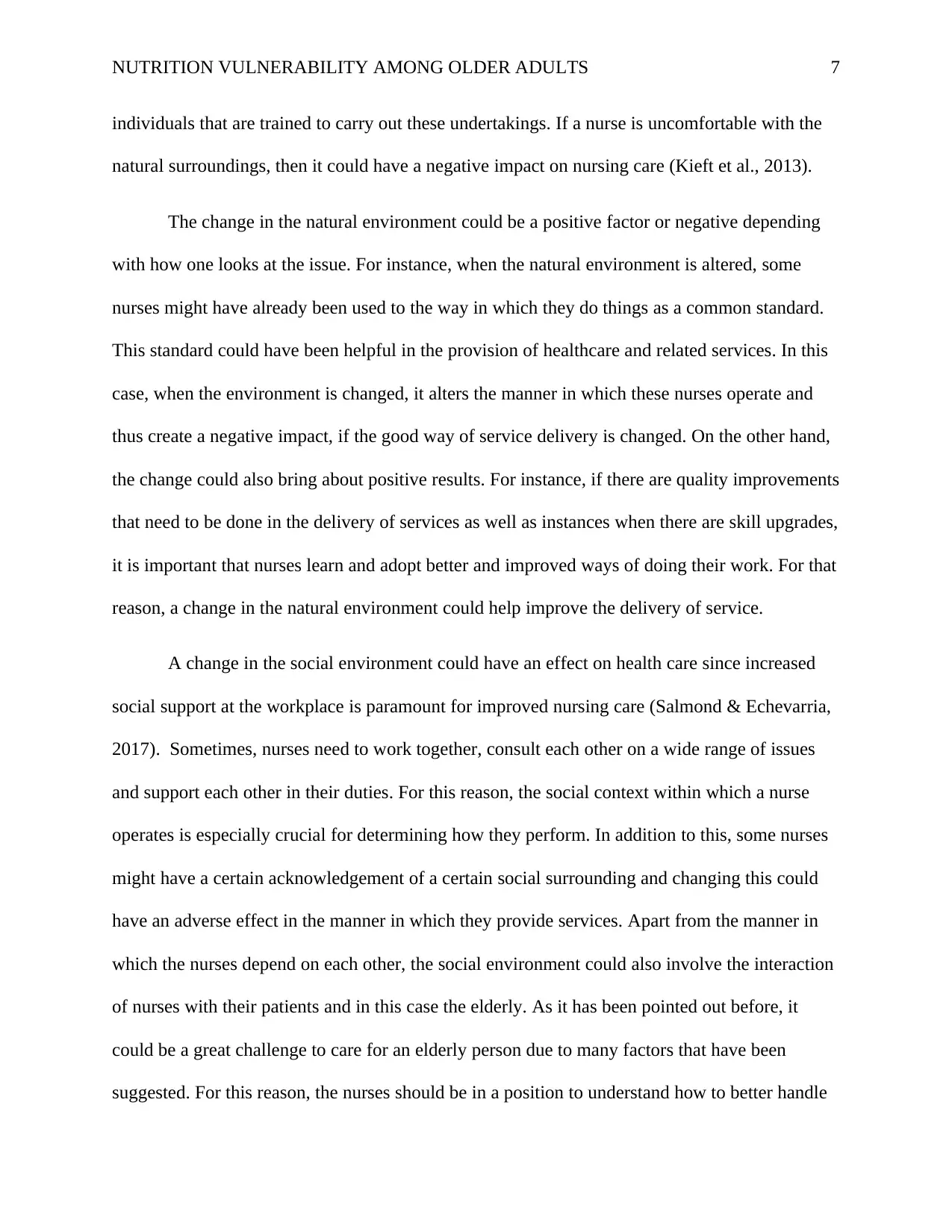
NUTRITION VULNERABILITY AMONG OLDER ADULTS 7
individuals that are trained to carry out these undertakings. If a nurse is uncomfortable with the
natural surroundings, then it could have a negative impact on nursing care (Kieft et al., 2013).
The change in the natural environment could be a positive factor or negative depending
with how one looks at the issue. For instance, when the natural environment is altered, some
nurses might have already been used to the way in which they do things as a common standard.
This standard could have been helpful in the provision of healthcare and related services. In this
case, when the environment is changed, it alters the manner in which these nurses operate and
thus create a negative impact, if the good way of service delivery is changed. On the other hand,
the change could also bring about positive results. For instance, if there are quality improvements
that need to be done in the delivery of services as well as instances when there are skill upgrades,
it is important that nurses learn and adopt better and improved ways of doing their work. For that
reason, a change in the natural environment could help improve the delivery of service.
A change in the social environment could have an effect on health care since increased
social support at the workplace is paramount for improved nursing care (Salmond & Echevarria,
2017). Sometimes, nurses need to work together, consult each other on a wide range of issues
and support each other in their duties. For this reason, the social context within which a nurse
operates is especially crucial for determining how they perform. In addition to this, some nurses
might have a certain acknowledgement of a certain social surrounding and changing this could
have an adverse effect in the manner in which they provide services. Apart from the manner in
which the nurses depend on each other, the social environment could also involve the interaction
of nurses with their patients and in this case the elderly. As it has been pointed out before, it
could be a great challenge to care for an elderly person due to many factors that have been
suggested. For this reason, the nurses should be in a position to understand how to better handle
individuals that are trained to carry out these undertakings. If a nurse is uncomfortable with the
natural surroundings, then it could have a negative impact on nursing care (Kieft et al., 2013).
The change in the natural environment could be a positive factor or negative depending
with how one looks at the issue. For instance, when the natural environment is altered, some
nurses might have already been used to the way in which they do things as a common standard.
This standard could have been helpful in the provision of healthcare and related services. In this
case, when the environment is changed, it alters the manner in which these nurses operate and
thus create a negative impact, if the good way of service delivery is changed. On the other hand,
the change could also bring about positive results. For instance, if there are quality improvements
that need to be done in the delivery of services as well as instances when there are skill upgrades,
it is important that nurses learn and adopt better and improved ways of doing their work. For that
reason, a change in the natural environment could help improve the delivery of service.
A change in the social environment could have an effect on health care since increased
social support at the workplace is paramount for improved nursing care (Salmond & Echevarria,
2017). Sometimes, nurses need to work together, consult each other on a wide range of issues
and support each other in their duties. For this reason, the social context within which a nurse
operates is especially crucial for determining how they perform. In addition to this, some nurses
might have a certain acknowledgement of a certain social surrounding and changing this could
have an adverse effect in the manner in which they provide services. Apart from the manner in
which the nurses depend on each other, the social environment could also involve the interaction
of nurses with their patients and in this case the elderly. As it has been pointed out before, it
could be a great challenge to care for an elderly person due to many factors that have been
suggested. For this reason, the nurses should be in a position to understand how to better handle
Paraphrase This Document
Need a fresh take? Get an instant paraphrase of this document with our AI Paraphraser
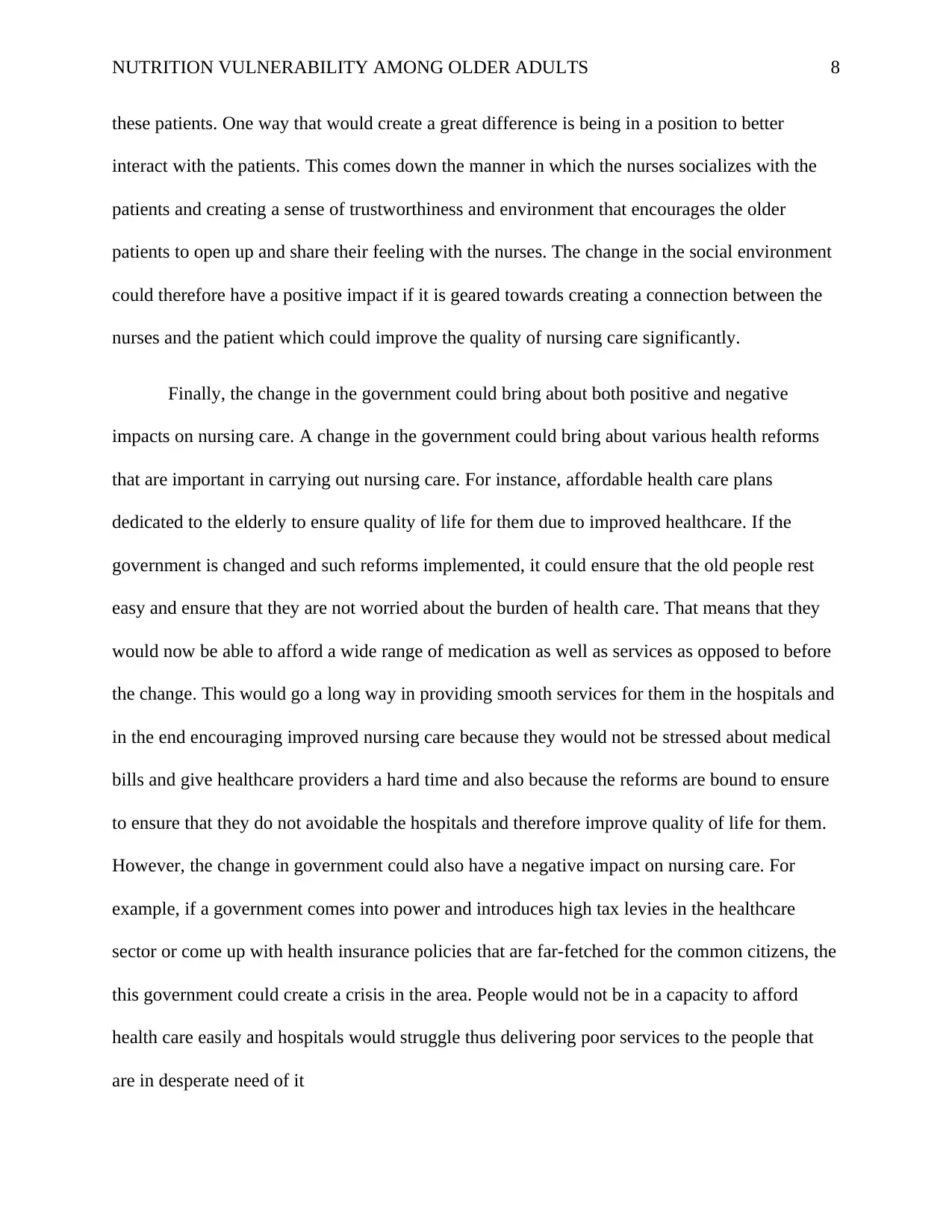
NUTRITION VULNERABILITY AMONG OLDER ADULTS 8
these patients. One way that would create a great difference is being in a position to better
interact with the patients. This comes down the manner in which the nurses socializes with the
patients and creating a sense of trustworthiness and environment that encourages the older
patients to open up and share their feeling with the nurses. The change in the social environment
could therefore have a positive impact if it is geared towards creating a connection between the
nurses and the patient which could improve the quality of nursing care significantly.
Finally, the change in the government could bring about both positive and negative
impacts on nursing care. A change in the government could bring about various health reforms
that are important in carrying out nursing care. For instance, affordable health care plans
dedicated to the elderly to ensure quality of life for them due to improved healthcare. If the
government is changed and such reforms implemented, it could ensure that the old people rest
easy and ensure that they are not worried about the burden of health care. That means that they
would now be able to afford a wide range of medication as well as services as opposed to before
the change. This would go a long way in providing smooth services for them in the hospitals and
in the end encouraging improved nursing care because they would not be stressed about medical
bills and give healthcare providers a hard time and also because the reforms are bound to ensure
to ensure that they do not avoidable the hospitals and therefore improve quality of life for them.
However, the change in government could also have a negative impact on nursing care. For
example, if a government comes into power and introduces high tax levies in the healthcare
sector or come up with health insurance policies that are far-fetched for the common citizens, the
this government could create a crisis in the area. People would not be in a capacity to afford
health care easily and hospitals would struggle thus delivering poor services to the people that
are in desperate need of it
these patients. One way that would create a great difference is being in a position to better
interact with the patients. This comes down the manner in which the nurses socializes with the
patients and creating a sense of trustworthiness and environment that encourages the older
patients to open up and share their feeling with the nurses. The change in the social environment
could therefore have a positive impact if it is geared towards creating a connection between the
nurses and the patient which could improve the quality of nursing care significantly.
Finally, the change in the government could bring about both positive and negative
impacts on nursing care. A change in the government could bring about various health reforms
that are important in carrying out nursing care. For instance, affordable health care plans
dedicated to the elderly to ensure quality of life for them due to improved healthcare. If the
government is changed and such reforms implemented, it could ensure that the old people rest
easy and ensure that they are not worried about the burden of health care. That means that they
would now be able to afford a wide range of medication as well as services as opposed to before
the change. This would go a long way in providing smooth services for them in the hospitals and
in the end encouraging improved nursing care because they would not be stressed about medical
bills and give healthcare providers a hard time and also because the reforms are bound to ensure
to ensure that they do not avoidable the hospitals and therefore improve quality of life for them.
However, the change in government could also have a negative impact on nursing care. For
example, if a government comes into power and introduces high tax levies in the healthcare
sector or come up with health insurance policies that are far-fetched for the common citizens, the
this government could create a crisis in the area. People would not be in a capacity to afford
health care easily and hospitals would struggle thus delivering poor services to the people that
are in desperate need of it
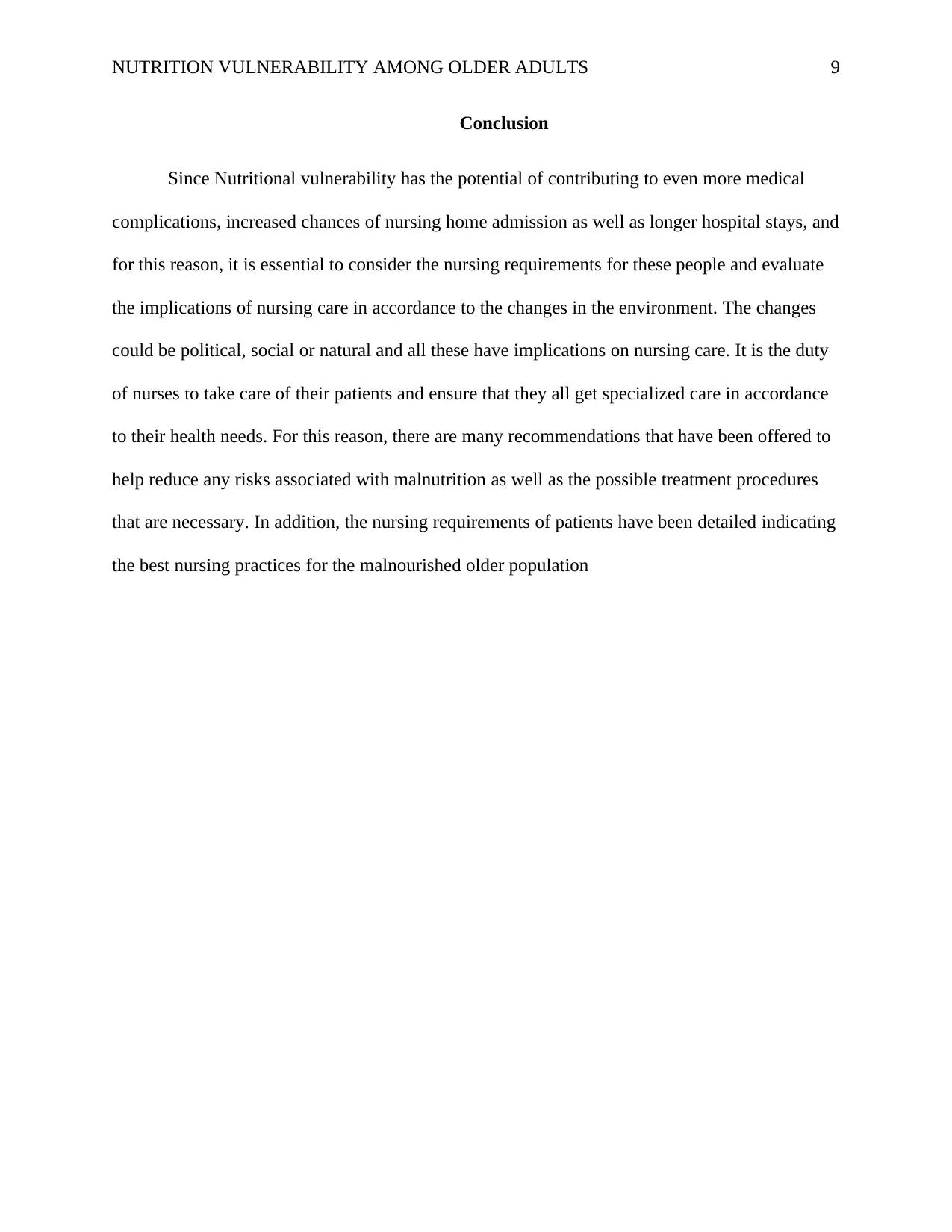
NUTRITION VULNERABILITY AMONG OLDER ADULTS 9
Conclusion
Since Nutritional vulnerability has the potential of contributing to even more medical
complications, increased chances of nursing home admission as well as longer hospital stays, and
for this reason, it is essential to consider the nursing requirements for these people and evaluate
the implications of nursing care in accordance to the changes in the environment. The changes
could be political, social or natural and all these have implications on nursing care. It is the duty
of nurses to take care of their patients and ensure that they all get specialized care in accordance
to their health needs. For this reason, there are many recommendations that have been offered to
help reduce any risks associated with malnutrition as well as the possible treatment procedures
that are necessary. In addition, the nursing requirements of patients have been detailed indicating
the best nursing practices for the malnourished older population
Conclusion
Since Nutritional vulnerability has the potential of contributing to even more medical
complications, increased chances of nursing home admission as well as longer hospital stays, and
for this reason, it is essential to consider the nursing requirements for these people and evaluate
the implications of nursing care in accordance to the changes in the environment. The changes
could be political, social or natural and all these have implications on nursing care. It is the duty
of nurses to take care of their patients and ensure that they all get specialized care in accordance
to their health needs. For this reason, there are many recommendations that have been offered to
help reduce any risks associated with malnutrition as well as the possible treatment procedures
that are necessary. In addition, the nursing requirements of patients have been detailed indicating
the best nursing practices for the malnourished older population
⊘ This is a preview!⊘
Do you want full access?
Subscribe today to unlock all pages.

Trusted by 1+ million students worldwide
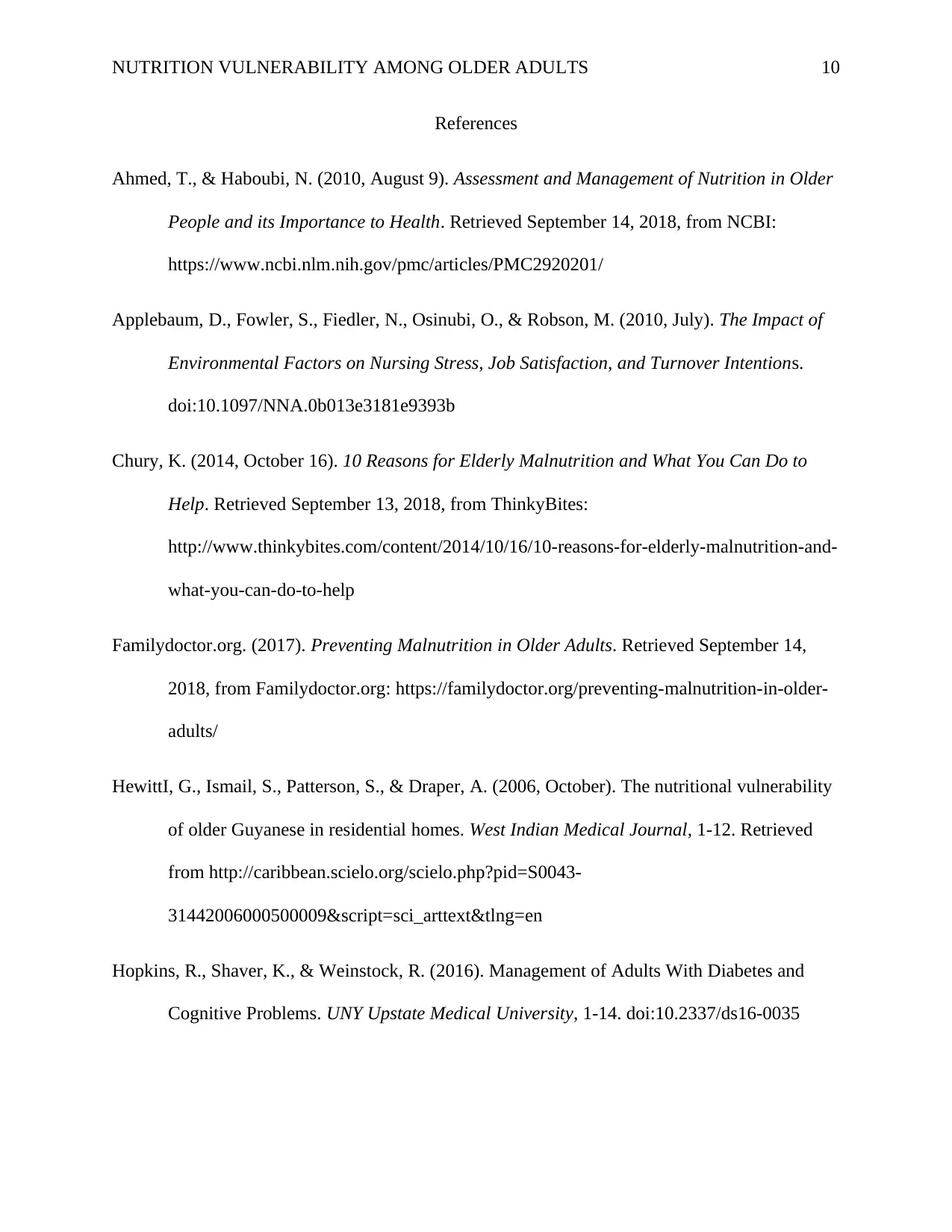
NUTRITION VULNERABILITY AMONG OLDER ADULTS 10
References
Ahmed, T., & Haboubi, N. (2010, August 9). Assessment and Management of Nutrition in Older
People and its Importance to Health. Retrieved September 14, 2018, from NCBI:
https://www.ncbi.nlm.nih.gov/pmc/articles/PMC2920201/
Applebaum, D., Fowler, S., Fiedler, N., Osinubi, O., & Robson, M. (2010, July). The Impact of
Environmental Factors on Nursing Stress, Job Satisfaction, and Turnover Intentions.
doi:10.1097/NNA.0b013e3181e9393b
Chury, K. (2014, October 16). 10 Reasons for Elderly Malnutrition and What You Can Do to
Help. Retrieved September 13, 2018, from ThinkyBites:
http://www.thinkybites.com/content/2014/10/16/10-reasons-for-elderly-malnutrition-and-
what-you-can-do-to-help
Familydoctor.org. (2017). Preventing Malnutrition in Older Adults. Retrieved September 14,
2018, from Familydoctor.org: https://familydoctor.org/preventing-malnutrition-in-older-
adults/
HewittI, G., Ismail, S., Patterson, S., & Draper, A. (2006, October). The nutritional vulnerability
of older Guyanese in residential homes. West Indian Medical Journal, 1-12. Retrieved
from http://caribbean.scielo.org/scielo.php?pid=S0043-
31442006000500009&script=sci_arttext&tlng=en
Hopkins, R., Shaver, K., & Weinstock, R. (2016). Management of Adults With Diabetes and
Cognitive Problems. UNY Upstate Medical University, 1-14. doi:10.2337/ds16-0035
References
Ahmed, T., & Haboubi, N. (2010, August 9). Assessment and Management of Nutrition in Older
People and its Importance to Health. Retrieved September 14, 2018, from NCBI:
https://www.ncbi.nlm.nih.gov/pmc/articles/PMC2920201/
Applebaum, D., Fowler, S., Fiedler, N., Osinubi, O., & Robson, M. (2010, July). The Impact of
Environmental Factors on Nursing Stress, Job Satisfaction, and Turnover Intentions.
doi:10.1097/NNA.0b013e3181e9393b
Chury, K. (2014, October 16). 10 Reasons for Elderly Malnutrition and What You Can Do to
Help. Retrieved September 13, 2018, from ThinkyBites:
http://www.thinkybites.com/content/2014/10/16/10-reasons-for-elderly-malnutrition-and-
what-you-can-do-to-help
Familydoctor.org. (2017). Preventing Malnutrition in Older Adults. Retrieved September 14,
2018, from Familydoctor.org: https://familydoctor.org/preventing-malnutrition-in-older-
adults/
HewittI, G., Ismail, S., Patterson, S., & Draper, A. (2006, October). The nutritional vulnerability
of older Guyanese in residential homes. West Indian Medical Journal, 1-12. Retrieved
from http://caribbean.scielo.org/scielo.php?pid=S0043-
31442006000500009&script=sci_arttext&tlng=en
Hopkins, R., Shaver, K., & Weinstock, R. (2016). Management of Adults With Diabetes and
Cognitive Problems. UNY Upstate Medical University, 1-14. doi:10.2337/ds16-0035
Paraphrase This Document
Need a fresh take? Get an instant paraphrase of this document with our AI Paraphraser
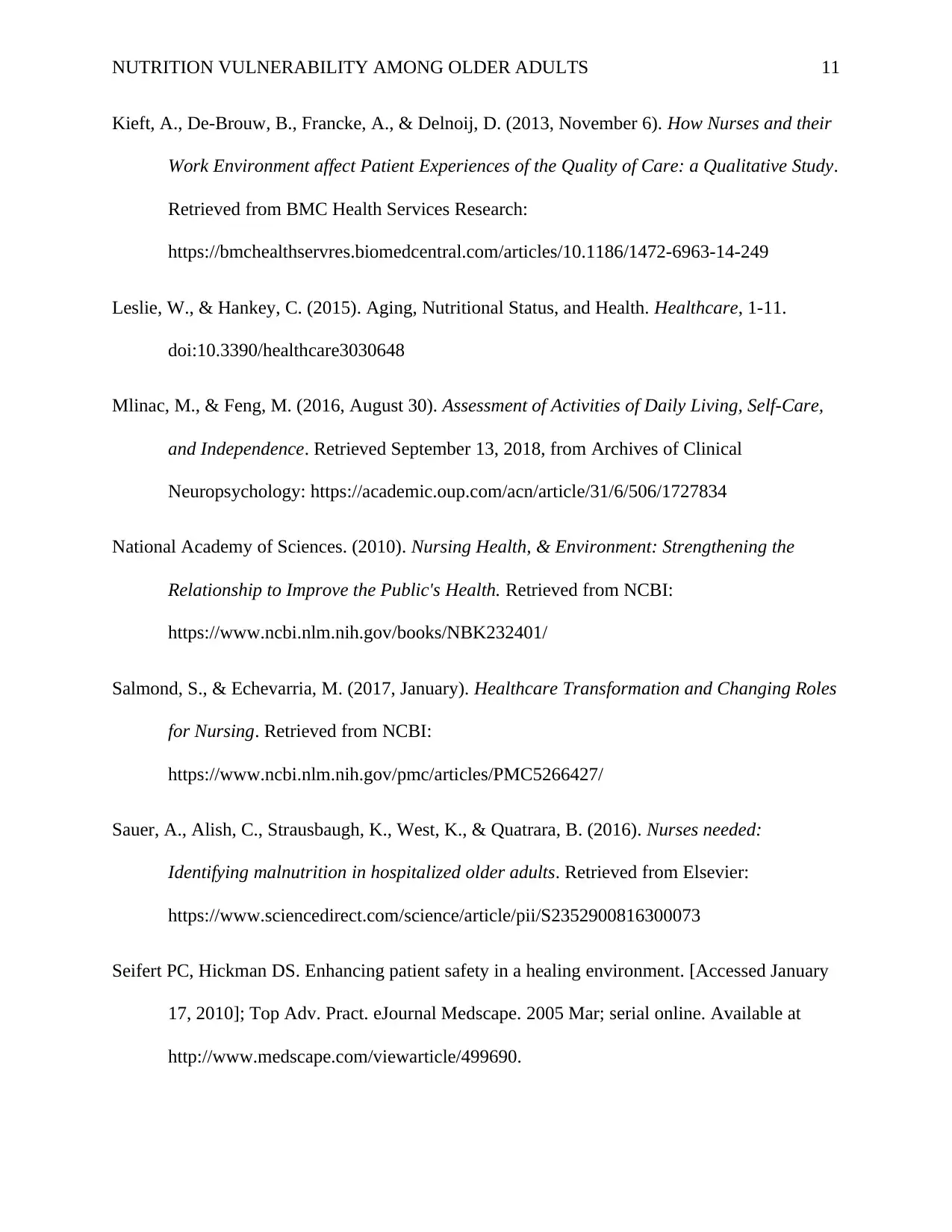
NUTRITION VULNERABILITY AMONG OLDER ADULTS 11
Kieft, A., De-Brouw, B., Francke, A., & Delnoij, D. (2013, November 6). How Nurses and their
Work Environment affect Patient Experiences of the Quality of Care: a Qualitative Study.
Retrieved from BMC Health Services Research:
https://bmchealthservres.biomedcentral.com/articles/10.1186/1472-6963-14-249
Leslie, W., & Hankey, C. (2015). Aging, Nutritional Status, and Health. Healthcare, 1-11.
doi:10.3390/healthcare3030648
Mlinac, M., & Feng, M. (2016, August 30). Assessment of Activities of Daily Living, Self-Care,
and Independence. Retrieved September 13, 2018, from Archives of Clinical
Neuropsychology: https://academic.oup.com/acn/article/31/6/506/1727834
National Academy of Sciences. (2010). Nursing Health, & Environment: Strengthening the
Relationship to Improve the Public's Health. Retrieved from NCBI:
https://www.ncbi.nlm.nih.gov/books/NBK232401/
Salmond, S., & Echevarria, M. (2017, January). Healthcare Transformation and Changing Roles
for Nursing. Retrieved from NCBI:
https://www.ncbi.nlm.nih.gov/pmc/articles/PMC5266427/
Sauer, A., Alish, C., Strausbaugh, K., West, K., & Quatrara, B. (2016). Nurses needed:
Identifying malnutrition in hospitalized older adults. Retrieved from Elsevier:
https://www.sciencedirect.com/science/article/pii/S2352900816300073
Seifert PC, Hickman DS. Enhancing patient safety in a healing environment. [Accessed January
17, 2010]; Top Adv. Pract. eJournal Medscape. 2005 Mar; serial online. Available at
http://www.medscape.com/viewarticle/499690.
Kieft, A., De-Brouw, B., Francke, A., & Delnoij, D. (2013, November 6). How Nurses and their
Work Environment affect Patient Experiences of the Quality of Care: a Qualitative Study.
Retrieved from BMC Health Services Research:
https://bmchealthservres.biomedcentral.com/articles/10.1186/1472-6963-14-249
Leslie, W., & Hankey, C. (2015). Aging, Nutritional Status, and Health. Healthcare, 1-11.
doi:10.3390/healthcare3030648
Mlinac, M., & Feng, M. (2016, August 30). Assessment of Activities of Daily Living, Self-Care,
and Independence. Retrieved September 13, 2018, from Archives of Clinical
Neuropsychology: https://academic.oup.com/acn/article/31/6/506/1727834
National Academy of Sciences. (2010). Nursing Health, & Environment: Strengthening the
Relationship to Improve the Public's Health. Retrieved from NCBI:
https://www.ncbi.nlm.nih.gov/books/NBK232401/
Salmond, S., & Echevarria, M. (2017, January). Healthcare Transformation and Changing Roles
for Nursing. Retrieved from NCBI:
https://www.ncbi.nlm.nih.gov/pmc/articles/PMC5266427/
Sauer, A., Alish, C., Strausbaugh, K., West, K., & Quatrara, B. (2016). Nurses needed:
Identifying malnutrition in hospitalized older adults. Retrieved from Elsevier:
https://www.sciencedirect.com/science/article/pii/S2352900816300073
Seifert PC, Hickman DS. Enhancing patient safety in a healing environment. [Accessed January
17, 2010]; Top Adv. Pract. eJournal Medscape. 2005 Mar; serial online. Available at
http://www.medscape.com/viewarticle/499690.
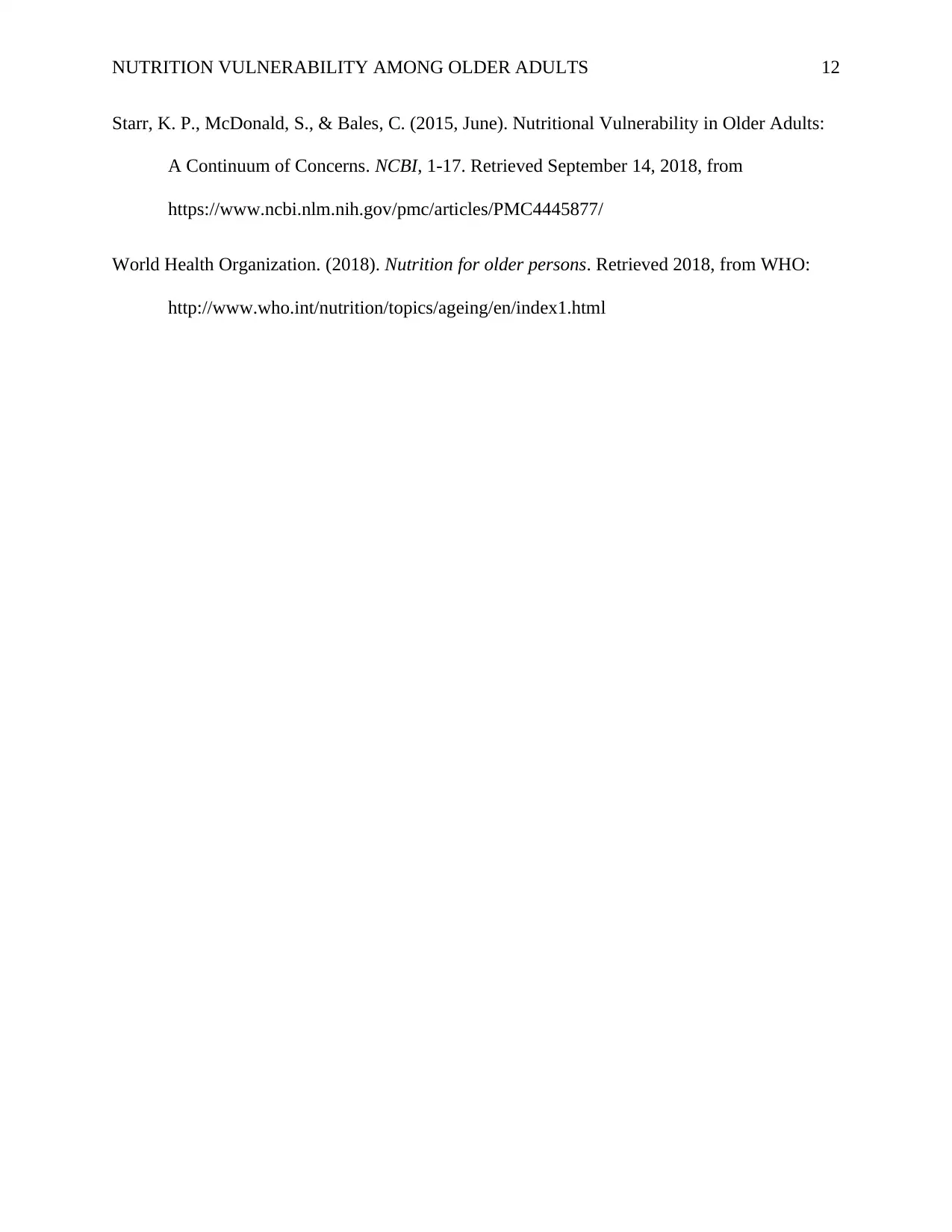
NUTRITION VULNERABILITY AMONG OLDER ADULTS 12
Starr, K. P., McDonald, S., & Bales, C. (2015, June). Nutritional Vulnerability in Older Adults:
A Continuum of Concerns. NCBI, 1-17. Retrieved September 14, 2018, from
https://www.ncbi.nlm.nih.gov/pmc/articles/PMC4445877/
World Health Organization. (2018). Nutrition for older persons. Retrieved 2018, from WHO:
http://www.who.int/nutrition/topics/ageing/en/index1.html
Starr, K. P., McDonald, S., & Bales, C. (2015, June). Nutritional Vulnerability in Older Adults:
A Continuum of Concerns. NCBI, 1-17. Retrieved September 14, 2018, from
https://www.ncbi.nlm.nih.gov/pmc/articles/PMC4445877/
World Health Organization. (2018). Nutrition for older persons. Retrieved 2018, from WHO:
http://www.who.int/nutrition/topics/ageing/en/index1.html
⊘ This is a preview!⊘
Do you want full access?
Subscribe today to unlock all pages.

Trusted by 1+ million students worldwide
1 out of 12
Related Documents
Your All-in-One AI-Powered Toolkit for Academic Success.
+13062052269
info@desklib.com
Available 24*7 on WhatsApp / Email
![[object Object]](/_next/static/media/star-bottom.7253800d.svg)
Unlock your academic potential
Copyright © 2020–2025 A2Z Services. All Rights Reserved. Developed and managed by ZUCOL.





